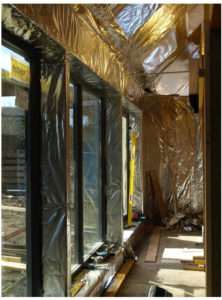By Niall Kerr, Postdoctoral Research Fellow (Energy and Climate Policy Effectiveness), School of Social and Political Science
Introduction by Faye Wade, Career Development Fellow (Energy and Society), School of Social and Political Science
The Scottish Government’s Energy Strategy suggests that, by 2050, Scotland’s domestic and non-domestic buildings will have undergone a ‘low carbon transformation’ – with a view to reducing greenhouse gas emissions and delivering a host of economic, social, health and regeneration benefits. Niall Kerr considers some of the reasons for retrofitting the British building stock:
According to some accounts the British housing stock is the oldest in Europe (Economidou et al., 2011). Due to low levels of construction and demolition, Britain is likely to be near the top of the European table for many years to come, with suggestions that around 70-80% of the buildings that will be in existence in 2050, are already standing (Royal Academy of Engineers, 2010). It is also estimated that around 90% of the average modern life is spent indoors (Klepeis et al., 2001). How our indoor environments are designed and constructed, therefore, has an inevitable impact on many different aspects of our lives.
The majority of British homes were built before the introduction of energy performance regulation, and partly as a result of this, they are notoriously leaky and energy inefficient. Energy use in our buildings – electricity use as well as gas, oil and solid fuels for heat – is currently responsible for about a quarter of Britain’s territorial carbon emissions. Legally binding climate change targets mean that by 2050 energy use in our homes is expected to be responsible for roughly none of our carbon emissions. Alongside climate change, the affordability of energy, and the concept of fuel poverty, have emerged as issues of political and social significance in recent years. The aged, leaky nature of UK housing is highlighted as one of the primary (if not the primary) causes of the problem. The difficulty in keeping our homes warm is also held partially responsible for various public health problems, both physical – respiratory, rheumatic – and mental – anxiety, depression. Strikingly, the UK has one of the highest rates Excess Winter Deaths (the phenomenon of more people dying in Winter than at other times of the year) in Europe, with the state of the British homes and the difficulty in keeping them warm, considered one of the principle factors for this (Liddell et al., 2015; Marmot Review Team, 2011).
With our current housing stock inevitably going to be with us for some time and the issues of climate change, fuel poverty and public health and housing on the political agenda (at least at times…) the question emerges of what, if anything, can we do to alter our inhabited spaces, and make them more energy efficient.
It is generally agreed that it is more cost and energy-effective to try and energy efficiently retrofit even the oldest, leakiest homes than to knock them down and build new ones (Power, 2011). Walls can be externally and/or internally insulated, windows can be replaced with more air-tight frames, and/or double or triple glazing panes, and EU appliance regulations have continually improved the efficiency of electrical and heating appliances.
In the retrofit industry certain retrofit options are considered as ‘low hanging fruit’, as they are relatively easy to install, relatively inexpensive and capable of saving substantial quantities of energy. Many homes in Britain will have, in recent years, had their loft insulated, any empty cavity walls filled with insulation, and/or a more efficient condensing boiler replace their previous heating system.
Rates of implementation for these low hanging options have increased significantly in the last 10-15 years. Due to the social benefits – lower carbon emissions, more affordable energy services – these increases have generally been driven by government support schemes, with the costs of additive measures like insulation, often either partly or completely subsidised by government, and the introduction of replacement measures, like boilers and appliances, supported via mandatory government efficiency regulations.
Numerous opportunities to retrofit British homes remain, with the potential to further address government social policy targets. As the easiest and most cost effective retrofit measures are often implemented as a priority, the options for retrofit that remain will, however, become progressively more expensive and more difficult to implement.
Retrofit (and energy efficiency more generally) is increasingly marketed as an activity that has ‘multiple benefits’ for both governments and for households (IEA, 2014). Governments are enticed to further support retrofit with the suggestion that it is not only socially beneficial – addressing climate change and fuel poverty – but that it also has economic benefits. More money spent on retrofit means less money spent on energy – investment rather than consumption spending. It is argued that this change in spending patterns will result in higher tax intake for government via higher net levels of employment (UKERC, 2014) and improved fiscal returns (Washan et al., 2014).
While there is a case for government spending on retrofit there is also a case for private households to invest without government support. Perversely the private case for retrofit has historically been considered to focus on the economic calculation of whether the investment in retrofit will offer enough of a reduction in energy bills to offer a payback. Current research suggests that to convince households to retrofit, the less quantifiable benefits, such as improvements in comfort, should be highlighted more clearly. It is also argued that retrofit should not be considered as distinct from general home improvements, as it is much more often than not carried out alongside general renovations (UKERC, 2013). Packaging retrofit measures into the installation of new kitchens and bathrooms is seen as an effective way of making homes more energy efficient.
While altering our homes to make them more energy efficient has clear benefits there are limits to how much can be done. Much of the older stock is revered for its architecture and its cultural significance, with the system of ‘listing’ buildings for protection seeing over half a million buildings with major restrictions placed on any alterations and significant retrofit probably out of the question (Brightman, 2012). While our older buildings create problems due to the difficulty in heating them, our younger buildings are far from perfect. The average floor space in newly built properties has generally fallen throughout the 20th century, with UK homes now considered on average to be the smallest in Europe (Morgan and Cruickshank, 2014). These smaller spaces are thought to be detrimental to inhabitant’s mental health, with the British public generally considering older British homes much more desirable than new ones, partly because of their space, their adaptability and their perceived cultural value (RIBA, 2012).
Whilst, as highlighted, there are many different reasons for retrofitting our existing homes both for the inhabitants and for the government, the pre-eminent driving force behind action is arguably climate change. Ultimately, climate change targets will mean that the supply of energy to our homes must result in low to zero carbon emissions. With the perceived multiple benefits of energy efficient retrofit and the low base of efficiency from which our homes are starting there are still many retrofit opportunities and many reasons to try and implement these. If the low carbon targets are to be achieved however, the issue of how much time, energy and investment that is put into improving energy efficiency as opposed to thinking about how we decarbonise our remaining supply requirement, will be a complex and contentious issue.
References
Brightman, M., 2012. Is the Conservation of the United Kingdom’s Built Heritage Sustainable? British Conference of Undergraduate Research (BCUR) 2012 Special Issue
Economidou, M., Laustsen, J., Ruyssevelt, P., Staniaszek, D., 2011. Europe’s Buildings Under the Microscope: a country by country review of the energy performance of buildings.
IEA, 2014. Capturing the Multiple Benefits of Energy Efficiency Capturing the Multiple Benefits of Energy Efficiency.
Klepeis, N.E., Nelson, W.C., Ott, W.R., Robinson, J.P., Switzer, P., 2001. The National Human Activity Pattern Survey (NHAPS) A Resource for Assessing Exposure to Environmental Pollutants.
Liddell, C., Morris, C., Thomson, H., Guiney, C., 2015. Excess winter deaths in 30 European countries 1980 – 2013: a critical review of methods. J. Public Health (Bangkok). 38, 806–814. doi:10.1093/pubmed/fdv184
Marmot Review Team, 2011. The health impacts of cold homes and fuel poverty., BMJ (Clinical research ed.). doi:10.1136/bmj.d2807
Morgan, M., Cruickshank, H., 2014. Quantifying the extent of space shortages: English dwellings. Build. Res. Inf. 42, 710–724. doi:10.1080/09613218.2014.922271
Power, A., 2011. Housing and Sustainability: deomolition or refurbishment. Urban Des. Plan. 163.
RIBA, 2012. Future Homes Commission – Building the Homes and communities britain needs.
Roberts, S., 2008. Altering existing buildings in the UK. Energy Policy 36, 4482–4486. doi:10.1016/j.enpol.2008.09.023
Royal Academy of Engineers, 2010. Engineering a low carbon built environment: The discipline of Building Engineering Physics.
UKERC, 2014. Low carbon jobs: The evidence for net job creation from policy support for energy efficiency and renewable energy.
UKERC, 2013. Understanding Homeowners ’ Renovation Decisions : Findings of the VERD Project.
Washan, P., Stenning, J., Goodman, M., 2014. Building the Future: The economic and fiscal impacts of making homes energy efficient.
 Thanks to a collaboration fund between the Universities of Sydney and Edinburgh, sponsored by the Partnership Collaboration Awards Programme, our two associated institutes (Sydney Environment Institute and Edinburgh’s Global Environment and Society Academy) were able to host an excellent workshop this summer on ‘Sustainable Materialism.’ Our focus was on flows of materials (including food, energy, clothing), through our everyday lives and if/how these flows and practices represent a new type of environmentalism. The delegates gathered at the Edinburgh Centre for Carbon Innovation (ECCI) in Edinburgh were amazingly diverse, representing disciplines of politics, environmental science, ecology, law, arts, architecture, literature, music, economics, sociology and more. Eleven papers analysed the people and groups engaged in environmental practices – food movements, community energy, sustainable crafting and fashion – and explored their motivations, forms, diversity and impact on social change.
Thanks to a collaboration fund between the Universities of Sydney and Edinburgh, sponsored by the Partnership Collaboration Awards Programme, our two associated institutes (Sydney Environment Institute and Edinburgh’s Global Environment and Society Academy) were able to host an excellent workshop this summer on ‘Sustainable Materialism.’ Our focus was on flows of materials (including food, energy, clothing), through our everyday lives and if/how these flows and practices represent a new type of environmentalism. The delegates gathered at the Edinburgh Centre for Carbon Innovation (ECCI) in Edinburgh were amazingly diverse, representing disciplines of politics, environmental science, ecology, law, arts, architecture, literature, music, economics, sociology and more. Eleven papers analysed the people and groups engaged in environmental practices – food movements, community energy, sustainable crafting and fashion – and explored their motivations, forms, diversity and impact on social change.





